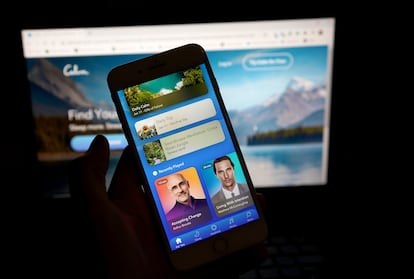Meditation apps: A wellbeing revolution or spiritual ‘fast food’?
Platforms such as Calm and Headspace have millions of users, but some experts warn they are temporary fixes that should not be used in place of therapy

The cellphone of Lucía García-Cabrera, a 31-year-old fashion designer, shows that she has meditated 328 days in a row with the Headspace app. “If I hadn’t been absent-minded some days, it would have been more than 400,” she says. García-Cabrera spends €50 a year to subscribe to Headspace – “the best €50 spent ever,” she says – and uses the app between 10 and 15 minutes a day, almost always before going to bed, and to do guided meditation. “My life has completely changed. I sleep much more deeply, I am more rested and during the day I do breathing exercises,” she says. “My perspective and vision of life have turned around. Everything goes very quickly and this is a way to say: we are going to stop and we are going to live in the present.”
García-Cabrera downloaded Headspace at the beginning of the coronavirus pandemic to help her manage the stress she felt from the constant stream of information about the virus. “You would put on the television and the bombardment of deaths was horrifying. This helped me to put things in perspective. I suppose that I could have meditated without the app, but it is easier for me to do it this way,” she says. Millions of people have made the same choice. The popularity of meditation and mindfulness apps has skyrocketed in the last 18 months.
Leading the boom are Calm, which has been downloaded more than 100 million times, and Headspace, which has more than 65 million downloads and last August merged with a platform funded by the investment fund Blackstone. Headspace was created by Andy Puddicombe, a Briton who spent 10 years training as a Buddhist monk and set up the app as a tool to help organize his own schedule. Now he lives in Silicon Valley and presides over a company that made more than €100 million in revenue in 2020. According to the Business of Apps news site, there are more than 5,000 similar meditation apps on the market, including Boom Journal, Ten Percent Happier, Buddhify, Calmer U and Mind U. All of them benefited from Apple’s decision to name Calm as the app of the year in 2017, and most grew during the pandemic.
It is not difficult to deduce why. Since March 2020, when the pandemic hit, there have been even more reasons to feel anxious and distressed, while solitude has worsened and seeing a therapist in person has become more difficult.

Although the apps have different functions, in general, they provide guided meditations that simplify relatively complex practices so they can fit into everyday life. “I find non-guided meditation, with a gong, difficult. I can’t do it,” says Gerard (not his real name), who has been using Calm for four years and feels more centered, the more he uses it. “There are two teachers, the legendary Tamara Levitt, and another one called Jeff Warren, who share a different meditation every day. It hooks you in quite a bit because they are all different and you end up having a relationship with them which is similar to the one you have with your yoga teacher,” he says. Gerard has a creative job and in moments of peak stress, when for example, he is publishing a new book, he has used the app for up to two hours a day. He says it helps him to manage the fear of failure and imposter syndrome.
There are still very few clinical trials on meditation apps, and those that have been carried out have been very small. Most, however, conclude that using this type of app does have a positive effect. In a study by Carnegie Mellon University, 140 adults were asked to practice mindfulness via an app for 20 minutes a day for two weeks. According to the research, the participants’ cortisol levels dropped and their blood pressure improved.
Maintaining that meditation is the cure for all problems is wrong and potentially dangerousMiguel Farias, professor at Coventry University
Despite this, some experts have misgivings about the use of mindfulness and meditation apps, both for the methods they use and the philosophy they preach. For Francesc Miralles, the author of self-help books such as Cuentos para quererte mejor (or, Stories to Love Yourself Better) and La biblioteca de la luna (or, Library of the Moon), meditating via a cellphone app voids the purpose of meditation. “Something that should serve to disconnect you from the mundane, from the projections of the past and future, becomes part of the everyday noise by being transmitted via a screen. There are things that should remain analog,” says Miralles, who also gives talks and teaches workshops. He is also skeptical about quantifying meditation. “Just like before the pandemic, when people would visit three countries in a week just to say they had been there, this also promotes the cult of speed. Anyone who has practiced meditation knows that the benefits come after many hours. Zen monks achieve satori [a term for awakening in Japanese Buddhism] after a lot of practice, but these applications promise results in five or ten minutes. Why not five seconds, while you’re at it? It perverts everything and gives you spiritual fast food.”
According to Miguel Farias, a professor of cognitive and biological psychology at Coventry University in the United Kingdom, the problem is not so much in the way the mediation apps work, but rather in what they teach. “Maintaining that meditation is the cure for all problems is wrong and potentially dangerous,” says Farias, who researches the impact of spiritual practices on the human mind. “Meditation does not help all individuals, and in some cases, it can even be counterproductive.” Farias is also worried that the apps are being used as a substitute for therapy, a trend that is already being seen in the United States, where 60% of the market for meditation apps is concentrated, and where access to healthcare is difficult and expensive. “An app is simply a product designed to be simple and it is developed with business goals in mind,” says Farias. “In no instance can it give you what a teacher who is aware of the subtleties of meditation and the individuals, including the potential dangers, can give.” In his book The Buddha Pill, Farias and the psychologist Catherine Wikholm warn that, after meditation, some people experience panic attacks or anxiety, and some cases of depression even worsen.
Both Farias and Miralles believe that the success of these apps is about what has come to be called “McMindfulness,” a term popularized by cultural researcher Ronald Purser. Purser argues that meditation has been turned into a tool for control and to pacify society – one that is now used by armies, schools and corporations. In this way, spirituality has been adjusted to fit within the capitalist system. “We are already seeing how meditation has been absorbed by neoliberalism,” says Farias. “Many companies now make their employees responsible for their own mental health at work. If you are stressed, it’s your duty to meditate with this app. If you continue to be stressed, you are not doing it right.” Search engine Google and professional networking site LinkedIn are among the more than 600 businesses that have agreements with Headspace.
Many individual users, however, only see meditation apps as a useful way to disconnect. García-Cabrera, for example, recommends Headspace to all of her friends. “I would never say it is a replacement for therapy, but it can complement it,” she says. “Spending five minutes with yourself does nobody any harm.”
Tu suscripción se está usando en otro dispositivo
¿Quieres añadir otro usuario a tu suscripción?
Si continúas leyendo en este dispositivo, no se podrá leer en el otro.
FlechaTu suscripción se está usando en otro dispositivo y solo puedes acceder a EL PAÍS desde un dispositivo a la vez.
Si quieres compartir tu cuenta, cambia tu suscripción a la modalidad Premium, así podrás añadir otro usuario. Cada uno accederá con su propia cuenta de email, lo que os permitirá personalizar vuestra experiencia en EL PAÍS.
¿Tienes una suscripción de empresa? Accede aquí para contratar más cuentas.
En el caso de no saber quién está usando tu cuenta, te recomendamos cambiar tu contraseña aquí.
Si decides continuar compartiendo tu cuenta, este mensaje se mostrará en tu dispositivo y en el de la otra persona que está usando tu cuenta de forma indefinida, afectando a tu experiencia de lectura. Puedes consultar aquí los términos y condiciones de la suscripción digital.
More information
Archived In
Últimas noticias
Most viewed
- David King, chemist: ‘There are scientists studying how to cool the planet; nobody should stop these experiments from happening’
- Mexico completes its trade shift with the entry into force of tariffs on China and countries without trade agreements
- Reinhard Genzel, Nobel laureate in physics: ‘One-minute videos will never give you the truth’
- Oona Chaplin: ‘I told James Cameron that I was living in a treehouse and starting a permaculture project with a friend’
- Sinaloa Cartel war is taking its toll on Los Chapitos










































